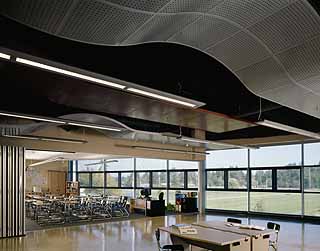|
Subscribe / Renew |
|
|
Contact Us |
|
| ► Subscribe to our Free Weekly Newsletter | |
| home | Welcome, sign in or click here to subscribe. | login |
Construction
| |
 |
September 22, 2005
Softening the landing for college freshmen
Northwest Architectural Co.

Stack
|
Students entering college from high school are often shocked by the rigor they encounter and sometimes feel ill-prepared for their course work.
In the August 2005 Better Schools e-Briefing from the Partnership for Learning, a study by Peter D. Hart Research Associates looked at how high school students and college instructors viewed students' high school preparedness.
College instructors estimate that 42 percent of recent high school graduates are not adequately prepared for college. Seventy percent of college instructors went on to say that they spend some class time or a significant amount of class time (24 percent) reviewing materials and skills that should have been taught in high school.
Instructors cited thinking analytically, work and study habits, and applying learning to problem-solving as the areas with which they were most dissatisfied. Seventy-six percent of college instructors said opportunities for real-world learning would improve this situation.

Photo courtesy of Northwest Architectural Co.
Newer schools, such as Kirkland Junior High, are designed to allow more personalized environments, including shared spaces for collaborative learning.
|
These statistics are important because they demonstrate the seeming disconnect between K-12 preparation and higher-ed expectations. Key questions are: What is happening in schools at these levels to cause this? And is there anything about the way schools are planned and designed that might affect this outcome?
No more 'cells and bells'
At the K-12 level there is much emphasis on the value of smaller schools, personalized instruction, collaborative learning, real-world learning, and encouraging students to construct meaning from their experiences.
Research suggests that traditional "cells and bells" designs that line up classrooms (cells) along double-loaded corridors and are organized along department lines with strict schedules (bells) do not provide an environment that generates the personalized and collaborative results that are desired.
Accordingly, high schools are now being designed as learning clusters or houses to make large schools seem smaller, and with central collaboration spaces in them to allow the group learning and team problem-solving to occur. Often these houses have their own administrators and counselors with varying degrees of autonomy from the central school administration.
Real-world experiences are provided through cooperative programs with local businesses, but these are able to benefit only a relatively small number of students.
Block schedules are often used so that a block of two periods can be put together to allow classes to go into greater depth on a subject than is possible in a typical 55-minute period.
In some high schools, classrooms have been discarded in favor of seminar rooms, lecture rooms and science labs that supplement individual student study cubicles. The goal in the design of these high schools is to create a learning environment that enables a variety of student-teacher interactions, allowing many different individual learning styles to be accommodated. They allow the collaboration and personalized instruction that are desired.
Changing settings
From this environment, students embark on the typical college experience, which can be very different from what they were accustomed to in high school.
Students used to personalized learning are suddenly in large lecture classes with hundreds of other students. Classroom settings are often closer to the cells and bells described above, and there is little personalization available.
At the college level, more is expected of students and the material is more specific to a particular field of study. The volume of material to cover is also so great that, until recently, no one has seen a way to convey it to students short of lectures and readings.
This situation is beginning to change as colleges increasingly look to how they can create more collaborative spaces in the college environment.
Personalizing higher ed
At the new Western Washington University Academic Instructional Center (AIC) now under design, in addition to classrooms and lecture halls, there are numerous informal spaces where students can gather in small groups to discuss the material they learn in class. These spaces are equipped with power outlets and are wirelessly connected to the Internet so students can study, conduct research and interact with each other and their instructors online.
Additionally, some AIC classrooms are designed to be more collaborative with more flexible furniture configurations and media outlets to allow a variety of collaborative instructional arrangements.
The Smith Center at Washington State University incorporates a wide range of classroom types geared toward experimenting with emerging and yet untried teaching methods.
The University of Idaho redeveloped its Commons Building based on the need to rethink how learning occurs. The university is also rethinking the "dorm" environment in a living-learning model that makes learning more a part of student life.
Private colleges are also emphasizing unique teaching and learning opportunities to differentiate themselves in the marketplace and attract more students by offering a more intimate and personalized educational experience.
As high school and higher-education institutions strive to personalize the learning experience, students are increasingly connecting to the Web to gather information and construct meaning from it for themselves. Learning then is taking place not only in the classroom, but also in the experiences students have in informal settings such as dorms, student commons, gathering spaces and on the Web.
The buildings we design must enable learning by providing a variety of inviting, stimulating and connected environments. To best serve the evolving educational needs of students, and thus give them a greater chance for success at all levels, designers need to consider every area of academic buildings a potential learning environment.
Greg Stack is the managing principal of Northwest Architectural Co.'s Seattle office. He has been planning and designing K-12 and higher-ed projects throughout the region for over 20 years.
Other Stories:
- Small schools best prepared to teach the new '3 R's'
- Communities play larger role in shaping schools
- Schools districts discover the value of sustainability
- How to meet new state rules and provide real value
- Top concern of every school staff: air quality
- New schools teach lessons on technology design
- Why process isn't a dirty word


